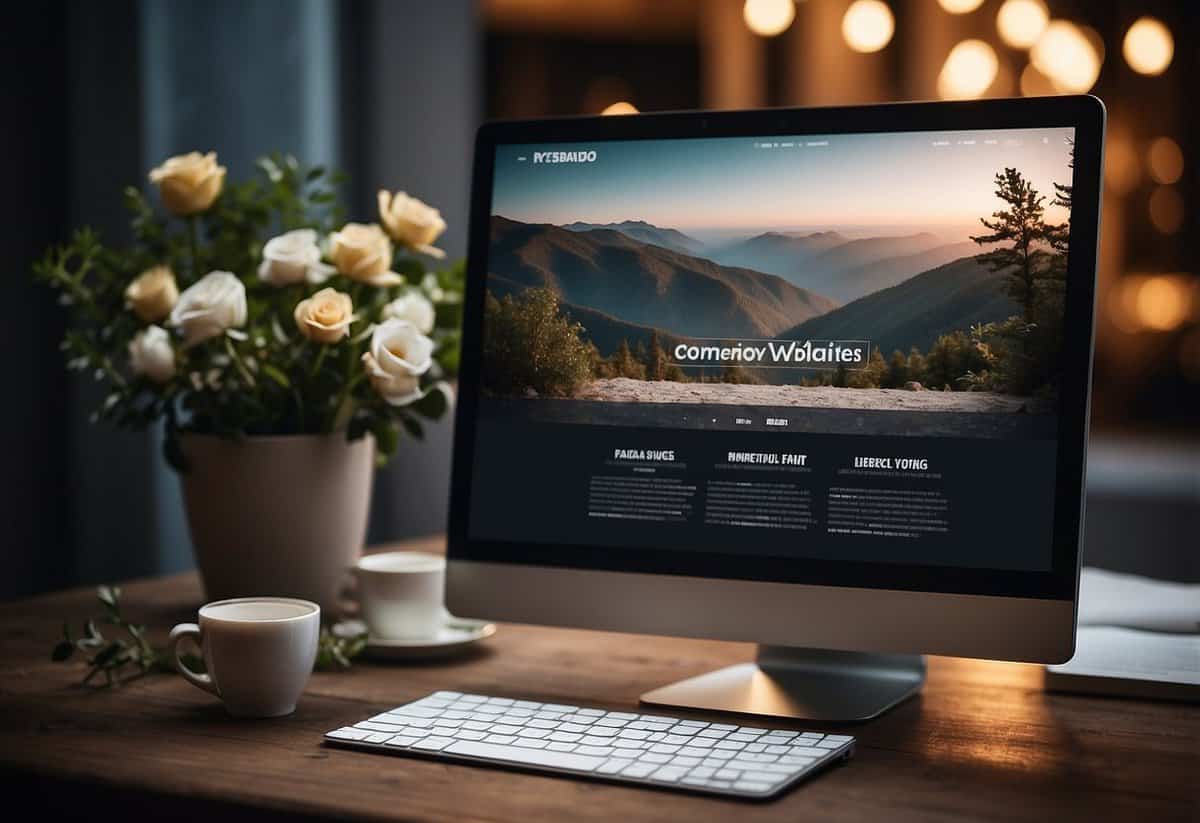When Should I Delete My Wedding Website? Tips for Newlyweds
Thinking about what to do with your wedding website once the big day has passed? You’re not alone. Many newlyweds wonder whether they should delete or simply deactivate their website. The ideal time to delete your wedding website is usually about one year after your wedding. This gives you enough time to use it for sharing honeymoon updates or keeping track of remaining registry items.

Guests often revisit the site during this period to find photos or get important updates. Keeping it active for a year also ensures that you have ample time to gather and save any special memories shared through the website.
After that, you might want to consider deactivating it to keep your online presence clean and focused. By then, most guests will no longer need to access it, and you can comfortably move on with your new chapter in life.
Deciding the Right Time to Delete Your Wedding Website

Choosing when to delete your wedding website depends on various factors such as completing thank-you cards, updating your registry, and sharing honeymoon updates. Understanding these details will help you make an informed decision.
After the Wedding
Once your wedding is over, you might think about deactivating your wedding website. This can be useful if you’d like to maintain some privacy and remove your wedding details from the web. Guests no longer need access to your wedding day information, and you can focus on other post-wedding tasks.
Still, some couples opt to keep their site active for a while. This allows them to post photos and updates about the honeymoon. Remember, deactivating doesn’t delete your content completely; you can reactivate if needed.
Post-Honeymoon Phase
When you return from your honeymoon, it might be time to think about winding down your wedding site’s usage. This is a good period to share any final thoughts, photos, or honeymoon stories with your guests. They often enjoy seeing how your first trip as a married couple went.
You might also use this time to make sure all your thank-you cards are sent out. Using your wedding website to post a final thank you message can also be a nice touch. Once these tasks are complete, you may decide it’s time to deactivate the site.
Completion of Wedding Related Tasks
Before deactivating, ensure all wedding-related tasks are done. This includes sending out thank-you cards (to thank your guests for their gifts and attendance), handling any registry returns, and sharing updates about your life post-wedding.
Don’t forget to freeze the top tier of your wedding cake and share any leftover stories or photos from the event. When you feel that you’ve completed these tasks and no longer need the site, it might be the perfect time to deactivate it.
Make sure you are notified by The Knot or your wedding website host about any deadlines. They usually keep your site active for up to one year after your wedding.
Steps to Delete Your Wedding Website

Deleting your wedding website involves several important steps. You should back up your memories, notify your guests, navigate to the dashboard, and finally, deactivate your website.
Back Up Your Memories
Before you delete anything, make sure to save all your important information. This includes photos, messages, guest information, and any special details you’ve uploaded.
Create a folder on your computer or cloud storage to keep everything safe. You might also want to save a copy of your wedding guestbook or any digital keepsakes that were part of your website.
Backing up your memories ensures you can look back on this special time in your life whenever you want.
Communicate with Your Guests
It’s important to let your wedding guests know that your website will be taken down. Send out an email or a message informing them of the timeline for deleting the site.
Provide any last-minute details they might need and thank them for being part of your wedding. This helps avoid any confusion and keeps everyone in the loop.
Some people might want to save pictures or other information, so giving them a heads-up is courteous.
Navigate to the Website Dashboard
Log into your user account where your wedding website is hosted. Go to the wedding website dashboard.
Here you will typically find options to manage and edit your site. Look for the settings or management section. This is where you will find the option to delete or deactivate your website.
Make sure to review any warnings or notifications that appear during this process. Some platforms, like The Knot, have guides to help you through this.
Final Deactivation
Once you’re ready, proceed to deactivate your wedding website. Follow the on-screen instructions to complete the deletion process.
Keep in mind that some sites, like Minted, might take up to seven days to complete the deletion. During this period, your website will no longer be accessible to guests.
Double-check that you have saved all necessary information before finalizing this step. Remember, once deactivated, it usually cannot be restored.
Considering Your Guests’ Needs

It’s important to keep your wedding website active for a while after the event to ensure your guests have all the information they need. This includes access to the registry, event photos, RSVP updates, and accommodation details.
Access to Registry and Event Photos
Your wedding website is a convenient place for guests to find your registry links. Even after the wedding, some guests might still want to send you gifts. Keeping the registry details accessible for a few months can be helpful.
Event photos are another important aspect. Guests will enjoy reliving special moments from your big day. Many couples use their websites to share a photo gallery. It allows everyone to view and download pictures without needing to use multiple platforms.
RSVP and Accommodation Information
Your wedding website might still be needed for post-wedding events. Some guests may have missed updating their RSVP. Keeping the online RSVP feature active can help you manage any updates or last-minute changes easily.
Accommodation information is also essential. If guests traveled from out of town, they might need details about local hotels and options for extending their stay. Maintaining this section can help ensure they have everything they need for a comfortable visit.
By considering these aspects, you can decide when it’s the right time for you and your guests to let the website go.
Managing Digital Footprint and Privacy

Handling your online presence carefully is important, especially when deciding to delete your wedding website. Key considerations include removing personal details, utilizing custom domains effectively, and adjusting privacy settings to control visibility.
Removing Personal Information
Deleting old and unnecessary accounts is a critical step in managing your digital footprint. Start by deleting any outdated or unused online accounts, including your wedding website. Personal information, like your full name, address, and contact details, should be removed from public view.
To do this, log in to your account and navigate to the settings to find the option to delete or disable the account. If the website doesn’t provide an option, contact customer support for assistance.
Custom Domain and Search Engines
A custom domain can offer more control over how your wedding website appears in search results. If you purchased a custom domain for your wedding website, you may have the option to repurpose it or let it expire.
Don’t forget that search engines like Google and Bing may still have copies of your site in their cache. To address this, request the removal of cached pages through tools like Google Search Console.
Adjusting Privacy Settings
Privacy settings are your first line of defense in controlling who can see your wedding website. Before deciding to delete, you can toggle visibility settings or password-protect the site.
Visit the settings on your website platform and look for options to make your site private or restrict access to certain users. Most platforms offer customizable privacy settings that allow you to reduce who can view your site without deleting it completely. This way, only those with the password can access your personal information.
By carefully considering these steps, you can manage your digital footprint effectively while keeping your personal information safe.
Alternative Options to Deleting Your Wedding Website

You might not need to delete your wedding website right after the big day. Instead, you have options like hiding it temporarily or renewing and repurposing it for other uses.
Hiding Your Website Temporarily
If you’re not ready to say goodbye to your site, you can hide your wedding website temporarily. This keeps it out of public view without deleting any content.
Log in to your account on the website platform (like The Knot or Zola).
Look for the option to deactivate or hide your site. For instance, on The Knot, use the dashboard to deactivate the site.
This hides your site from visitors while retaining all the information you’ve uploaded. It’s a perfect solution if you plan to update or repurpose your site later.
Renewing or Repurposing the Website
Renewing your wedding website can be a practical choice. Many platforms, including The Knot, allow you to keep your site active for an additional year or even longer if you renew.
Renew the site to continue sharing post-wedding updates, honeymoon photos, or registry details. Some couples use the custom domain to turn the website into a blog or a personal page.
Doing this prevents your hard work from going to waste. Plus, guests can revisit the site to see new updates. Just remember to check the renewal costs and terms specific to your platform.




